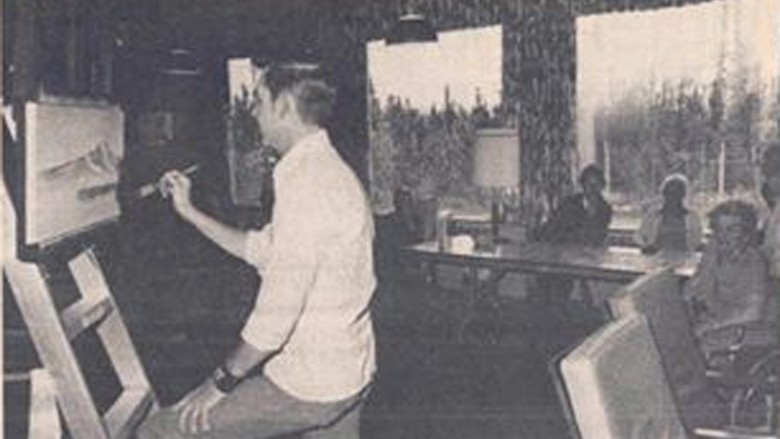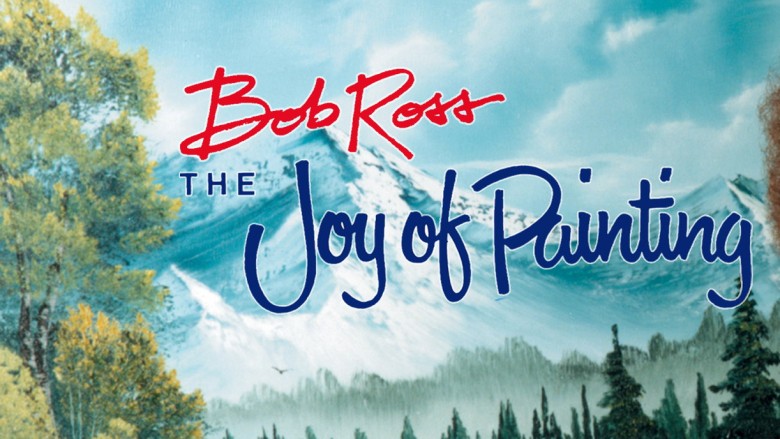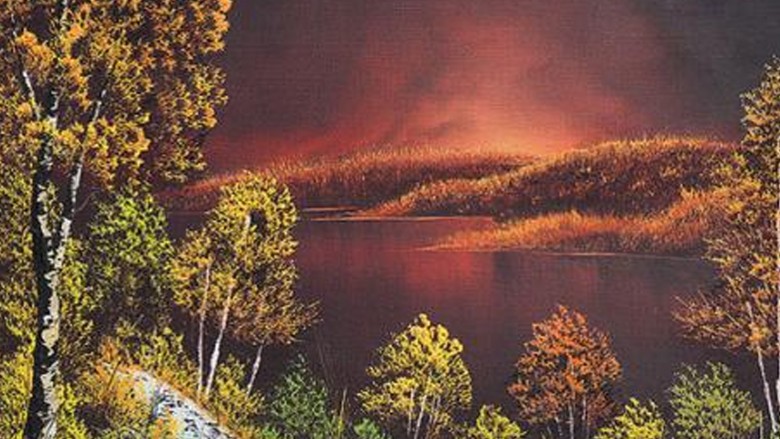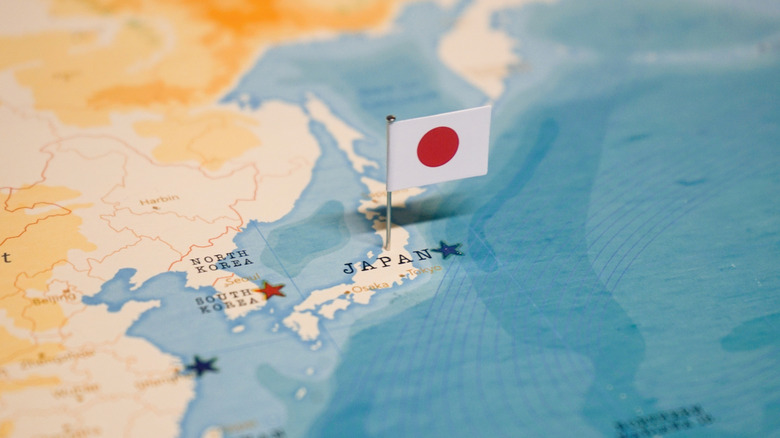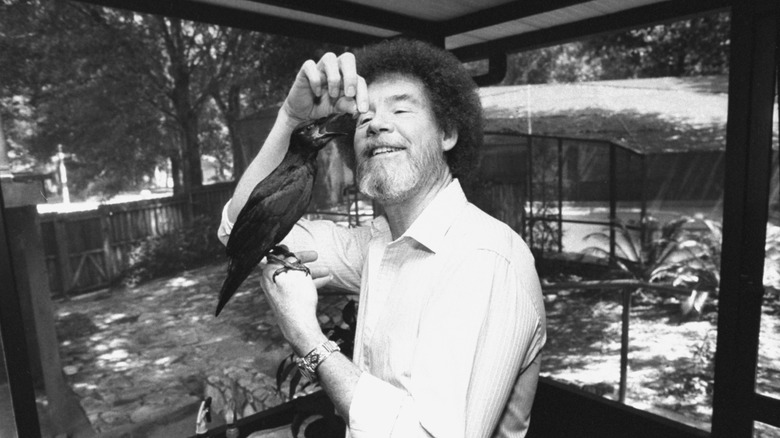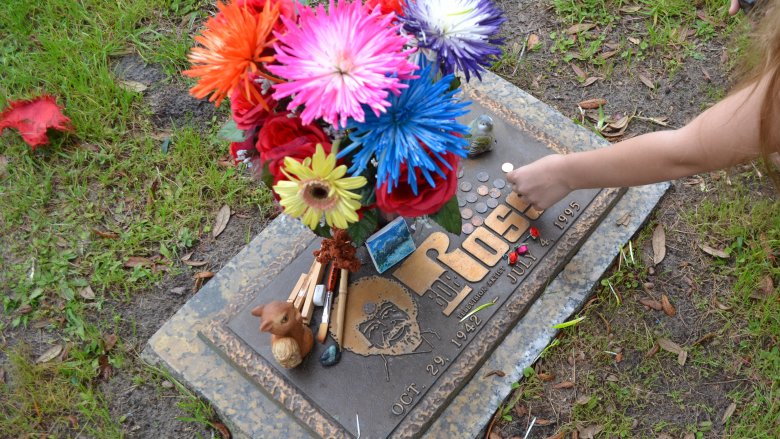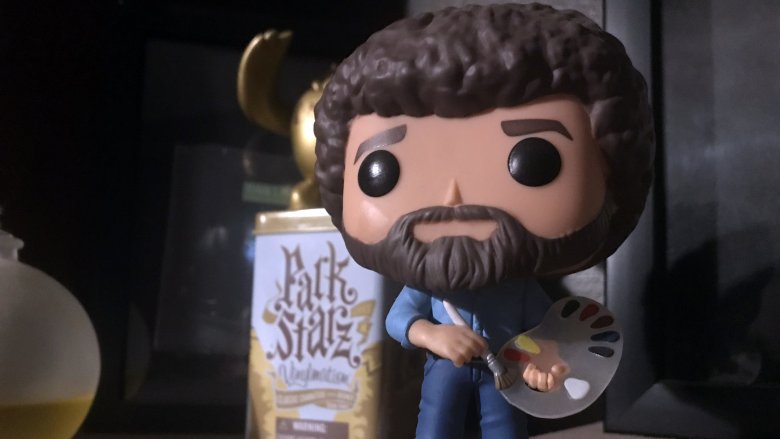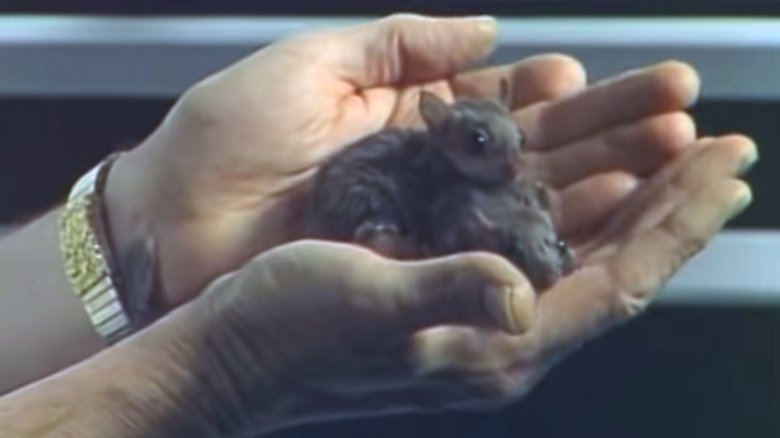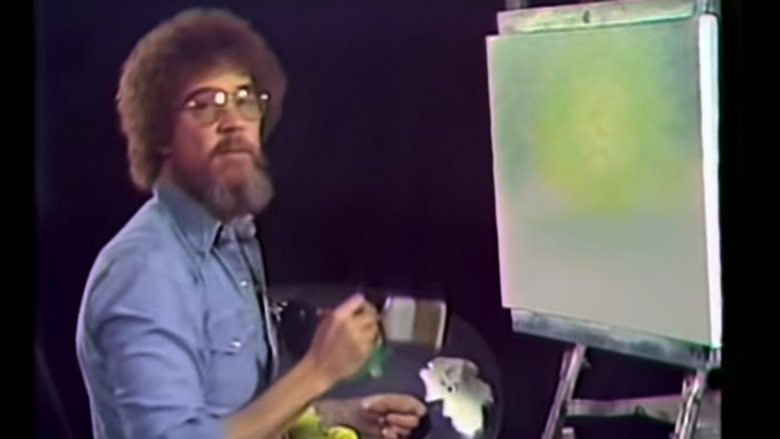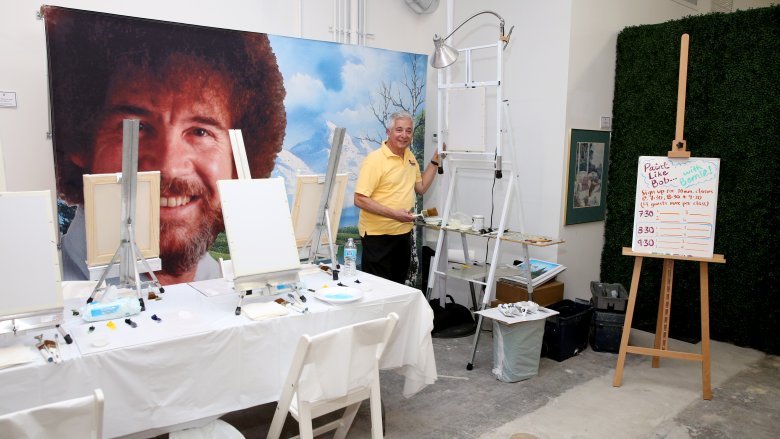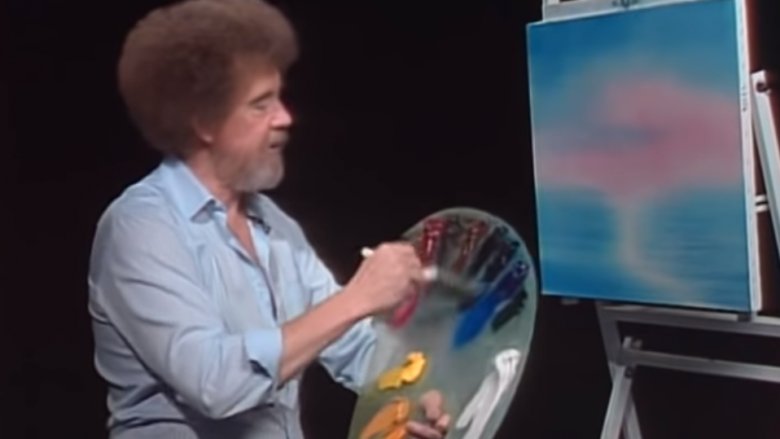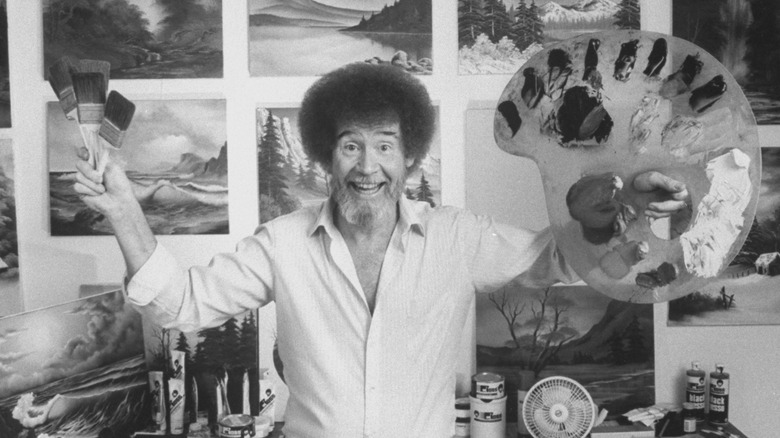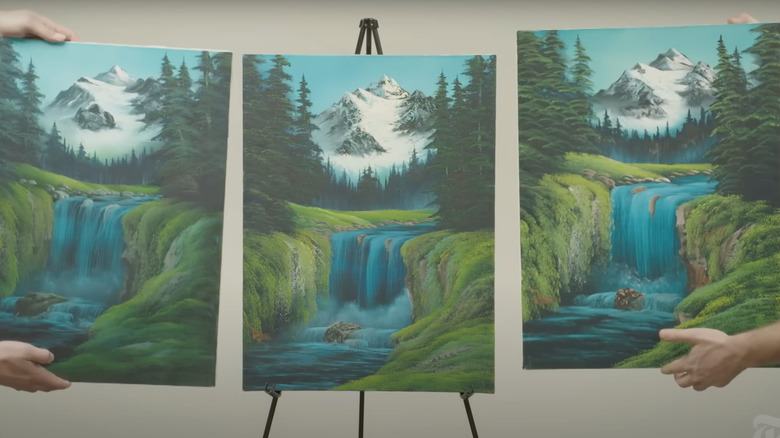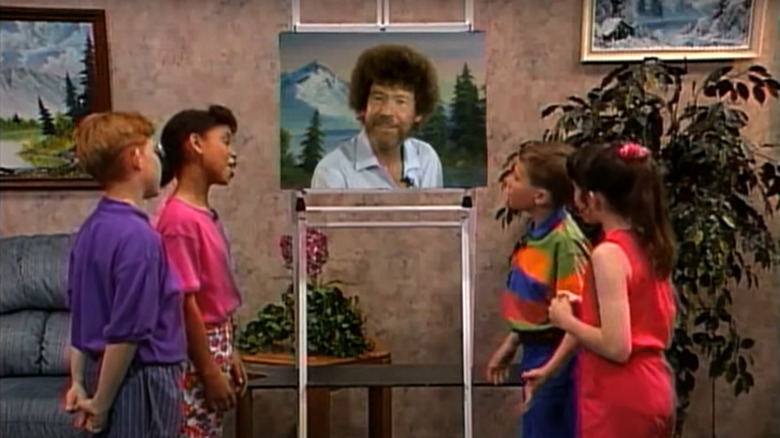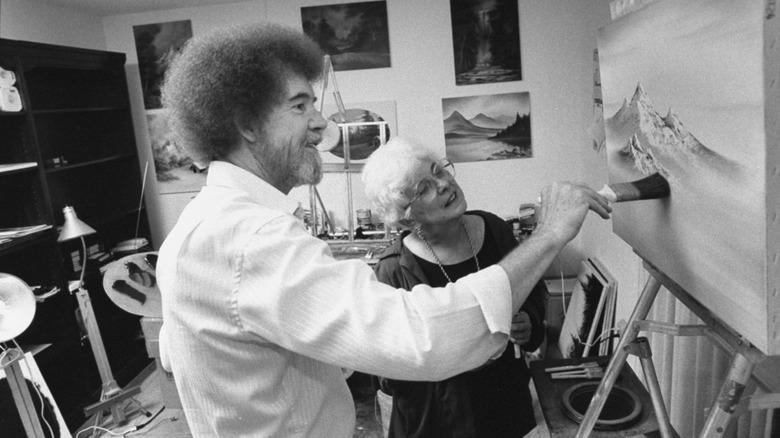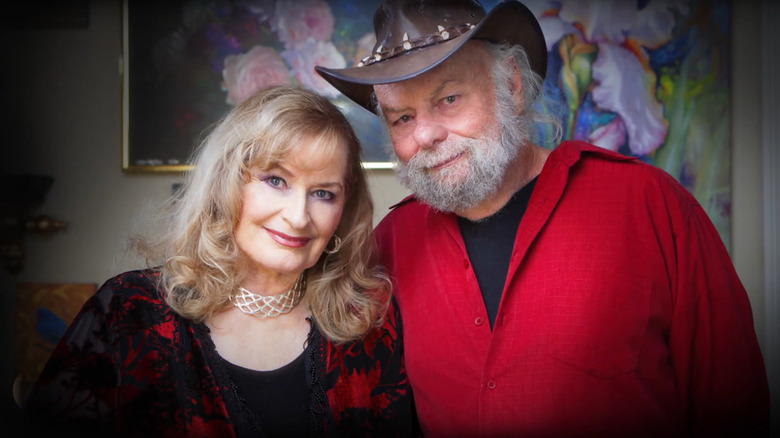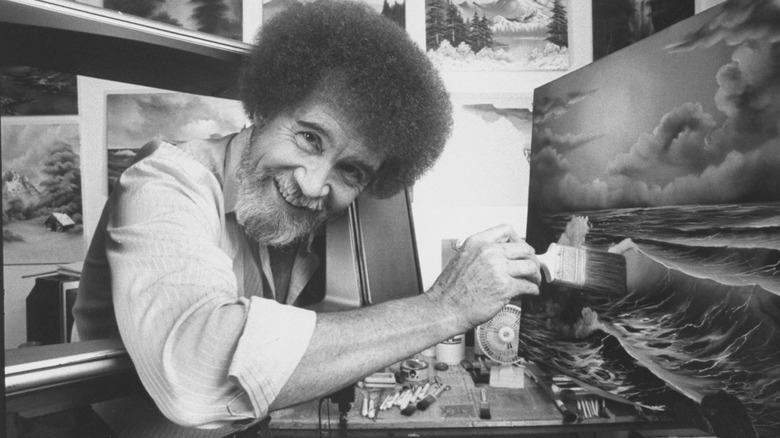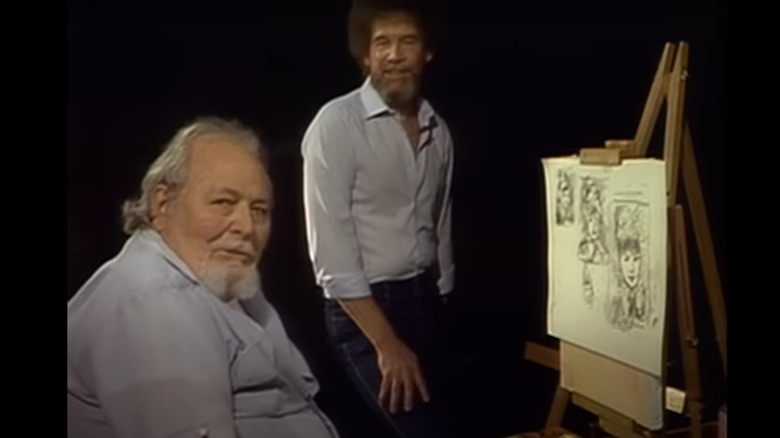What You Didn't Know About The Life Of Bob Ross
Bob Ross. Just his name brings a calm. The soft-spoken painter who didn't make mistakes, only "happy accidents," painted on PBS stations in the 1980s and 1990s. His untimely death in 1995 at the age of 52 occurred just when he was exploding on the pop culture scene. He appeared in a hip MTV spot back when MTV was hip, and then his sudden death seemingly extinguished all he had built.
But Bob Ross lives on. There was a resurgence of interest in Ross' "The Joy of Painting" during the COVID-19 pandemic, and a 2021 documentary delved into the painter's history and legacy. But there's so much people don't know about Bob Ross, and so much that will surprise you about the guy with the sweet pipes and sweeter 'fro.
He had a rival
To the viewer, Bob Ross is that happy guy who paints happier trees and clouds and rivers. To the artist, Bob Ross is a guy who paints in a very specific and unique way: wet on wet, where paint is applied on a still-wet coat to create the finished piece. Wet on wet dates back to the 1300s, and French impressionists used the method up to the early 20th century. The word on wet on wet is that no serious artist uses it, and then Bob Ross came along and ... well, critics don't really like him either, but that's not the point.
Ross himself began painting in Alaska and learned his technique from a famed (sort of) wet-on-wet painter, Bill Alexander. The German-born Alexander appeared on public television before Ross ever did, in the 1970s. Ross dedicated an episode of his "Joy of Painting" program in Season 2 to his teacher and mentor, but things soured from there. By 1991, Ross wouldn't even mention Alexander by name, telling The New York Times, "Now he is our major competitor."
Alexander was okay with it. And by "okay," we mean he said, "I invented 'wet on wet.' I trained him, and he is copying me — what bothers me is not just that he betrayed me, but that he thinks he can do it better." Hard to imagine anyone being mad at Bob Chillpants Ross, but it goes to show you: Everyone has a rival. Someone out there probably hated Mister Rogers, too.
He was a mean Air Force guy
Bob Ross is the last guy you'd expect to be angry with anyone, but he wasn't always a soft-spoken painter. Ross was born in Daytona Beach, Florida, and made his home in Orlando. If you're wondering how a Florida man made it up to freezing Alaska, he did it the honest way: by joining the military.
Bob Ross enlisted in the Air Force at age 18 and was stationed at Eielson Air Force Base in Alaska — a little south of Fairbanks. Ross served 20 years, achieving the rank of master sergeant, before retiring.
Ross wasn't the softy we know and love during his time in the military. He recalled that, "I was the guy who makes you scrub the latrine, the guy who makes you make your bed, the guy who screams at you for being late to work." After Ross left the Air Force, he vowed never to yell and scream again — which led to his calming TV demeanor.
His 'fro isn't natural
As recognizable as his sweet voice, the afro Bob Ross sports is the stuff of legend. It's a meme in itself, and every knock-off Halloween afro seller can attribute every single sale to people dressing up like Bob Ross. But Ross' 'fro is as real as his rivalry with Picasso. The trademark hair is just a perm.
But wait, it gets better. He got a perm to save money — no need to waste precious cash on a haircut when it will all just grow into a big ball of awesomeness. And he hated it. He hated every stinkin' curl on his skull, but he couldn't undo his money-saving strategy. The afro became the logo for his company. His business partner Annette Kowalski told NPR, "He could never, ever, ever change his hair, and he was so mad about that. He got tired of that curly hair." He was the only one.
He didn't make any money from his PBS show
Bob Ross achieved fame for his PBS show "The Joy of Painting," but it didn't pay the bills. In case you forgot, PBS stands for Public Broadcasting Service — as in a nonprofit station that gets 15% of its funding from the government. So obviously Ross wasn't swimming in it as a PBS star, but he had to make something, right? Eh ... not really.
Ross said he never got paid for his "Joy of Painting" program. As in nothing. "People see you on television and they think you make the same amount of money that Clint Eastwood does," he told the Orlando Sentinel in 1990. "But this is PBS. All these shows are done for free." No wonder Clint Eastwood never permed his hair! Ross made his money teaching and selling books, and of course selling some of his paintings. Ross also sold videos (remember those?) of his painting system — which were really three-hour workshops that went into more detail on his style.
He almost never painted people
In 2014, the statistical website FiveThirtyEight finally answered the paradox that has kept mortal man up all night: What exactly did Bob Ross paint?
"The Joy of Painting" aired 403 times in its original run — Ross only painted 381 times; the other episodes featured guests. As FiveThirtyEight explains, there were 3,224 elements that appeared in his paintings (they're detailed oriented). You know what Bob liked? Trees. A whopping 91% of his paintings contained at least one tree. You know what Bob didn't like? Flowers. Flowers are for suckers. Only 2% of his paintings contained flowers. He only painted palm trees 2% of the time also, but what do you expect? They're everywhere in Florida. He was probably sick of 'em. If Ross painted a tree (singular), there was a 93% chance he'd paint a second tree. Because trees shouldn't be alone, obviously. Surprisingly, for a guy known for his "happy little clouds," his paintings only featured clouds 44% of the time. But the only thing he hated more than flowers and palm trees were people. In his 381 televised paintings, only one featured a person. It was in silhouette against a tree — a lonely cowboy. And of the 18% of the time that he painted cabins, only one had a chimney. Must be pretty cold in Bob Rossland.
His originals are worth bank
Actually coming across an original Bob Ross isn't as easy as it seems. For the 381 programs that featured his paintings (thanks again, geeks at FiveThirtyEight!), he created three paintings pe show — one he painted on camera, one beforehand that he used as a guide, and one for close-ups and photography later (ah, the magic of editing). That means he produced 1,143 paintings during his show. Where are they?
For starters, he donated most to PBS stations, which auctioned them off. That presents a little bit of a problem in the art world. "Provenance" is a fancy word in the art world for "I got this from the artist, here's the proof." A simple "I bought it from the PBS station in Peoria" isn't going to cut it. But if somehow you have provenance, or just a lot of cash lying around, you can purchase an original Bob Ross — and they ain't cheap. A low-end Ross can run well over $10,000. In 2023, Ross' painting from the very first episode of "The Joy of Painting" sold for $9.8 million. That's a whole lot of happy trees.
He is mesmerizing
Let's be honest. The reason Bob Ross became so popular wasn't a sudden interest in wet-on-wet painting. He had a unique look, and his voice could stop a war. His soothing, dulcet tones just sent people to their happy place. There's something about watching a guy paint clouds and trees in a pacifying voice that relaxes people. "We've gotten letters from people who say they sleep better when the show is on," Ross said in a 1990 interview with the Orlando Sentinel. And that is the truth.
There's this thing called Autonomous Sensory Meridian Response, or ASMR. What people with ASMR get when they hear Bob Ross is "the tingles" — a calming, pleasing feeling that is usually associated with sex. Jenn Allen, the founder of ASMR-research.org, chose the word "meridian" because it's a synonym for "orgasmic."
Researchers are only beginning to understand the science of ASMR, but those who experience it pity those who don't. Have you ever heard a good song and it just gives you that feeling? That's frisson, and it's real. So there is precedent for "something" happening related to sound and the arts. A common thread is that people with post-traumatic stress disorder or insomnia benefit from Bob Ross and his ASMR powers. We'll let you decide if the phenomenon is real or not, preferably by listening to him alone in a darkened room.
He was big in Japan
When you think of the fame of Bob Ross — especially the pop culture icon he became all these years after his death — you don't consider it on a global scale. Yet, somehow, Bob Ross has a following worldwide.
There are certified Bob Ross instructors around the world, but for some reason, Japan took to Bob Ross like Germans to David Hasselhoff. Japanese television station NHK aired "The Joy of Painting" twice a day for years, and despite a Japanese voiceover translation — something most foreign countries airing the show did not use – the smooth pipes and relaxing mannerisms carried over perfectly. Bob Ross was big in Japan. When he visited the country, Japanese fans mobbed him like he was Madonna or Michael Jackson. His legacy continues there today. Artist Kenichi Yoneda, inspired by Bob Ross, paints using a computer code to create watercolors.
Friend of baby animals
The only thing that Bob Ross enjoyed more than painting was animals. Ross began his painting show in Muncie, Indiana, and immediately facilitated animal rescue organizations there. Back at his home in Orlando, Ross turned his backyard into an animal rehabilitation center, caring for squirrels, birds, and pretty much anything that popped up. He even had a pet crow named Midnight (pictured), who had taken a bullet to a wing and could never be released back into the wild.
He didn't need a big excuse to show off animals during his painting program. During the original 11-year run of "The Joy of Painting," Ross brought squirrels, opossums, owls, robins, blue jays, chimney sweeps, and other animals onto the show. The official Ross site cashes in, selling wildlife-themed brushes and offering to teach you how to paint a jaguar for a small fee. It might not be the legacy that Bob Ross intended, but such is life.
His son Steven is a painter
On the 403 "Joy of Painting" episodes, the most frequent guest was Bob's son Steven. With his hair-band looks, Steve certainly didn't look the part of painter, but his technique without a doubt was on par with his dear old dad.
Steve doesn't have a lot to do with the Bob Ross empire. A falling out of sorts happened after his father's passing, and Steve left Bob Ross Inc. For years after his father's death in 1995, Steve experienced depression that made it difficult for him to paint. He kept making art and teaching for a while but finally dropped out of sight for some 15 years.
That changed in 2019, when Steve led a painting seminar with Bob's close friend and frequent "Joy of Painting" guest star Dana Jester. Since then, Steve has traveled extensively to teach painting classes. A heart attack sidelined him again in 2022, but in late 2023 he appeared in-person to accept Florida's Artist Hall of Fame award on behalf of his late father.
If you or someone you know needs help with mental health, please contact the Crisis Text Line by texting HOME to 741741, call the National Alliance on Mental Illness helpline at 1-800-950-NAMI (6264), or visit the National Institute of Mental Health website.
Bob Ross has a surprising shrine
If you were a regular viewer of PBS, you probably didn't notice anything different about Bob Ross during his 1994 season. His final episode, which first aired April 5, 1994, seemed like every other episode. Little did anyone know that he was very ill. Joan Kowalski of Bob Ross Inc. told the Orlando Sentinel in 1995 that Ross had battled lymphoma for years. His wife Jane died of cancer a few years before the terrible disease took him.
Ross lived in the greater Orlando area — he was born just up the road in Daytona Beach and grew up in Orlando — so his final resting place is fittingly where he called home. On the west side of Orlando, nestled between Windermere and Ocoee, sits the tiny town of Gotha. If you drove by it and blinked you'd miss it, but down among the new subdivisions sits a picturesque cemetery — so pretty you could paint it — and there resides the grave of Bob Ross. It's not the easiest grave to find, toward the back of the cemetery but not far from the road. The easiest way to locate it is to look for the artwork. Fans leave their own Ross-inspired works along with miniature animal figurines and paintbrushes to pay tribute to the artist.
He's still everywhere
Bob Ross, somehow, is even more popular today than he was during his life. He has become this go-to pop culture icon that naturally brings a smile to everyone's face when they see that familiar afro. He's also shockingly trendy on the interwebs. How trendy? Well, you know you've made it when they make a Funko Pop of you. And Bob Ross has more than one. Ross once again became a thing in 2018 when his likeness popped up in a most unexpected place.
Ryan Reynolds' Deadpool parodied Bob Ross in a super NSFW teaser trailer for "Deadpool 2" — and he really nailed it. From the seemingly oddball colors (which were part of the joke for Deadpool) to the ... trippy feeling that some get from Ross' vocals, the Bob Ross machine once again hit viral news. And of course there's a Funko Pop of Deadpool as Ross because there has to be.
He gave high-fours
Bob Ross didn't complete high school, dropping out in the ninth grade. But he wasn't running the mean streets of Orlando; instead, he worked with his father as a carpenter. There's no telling how good (or bad) he was at woodworking, but It was during his time as a carpenter that he accidentally lost part of his finger in a saw accident. Despite his later claims, he probably didn't call it a "happy little accident" at the time. He lost the top part of his left index finger, and you probably never even noticed it. Why?
Ross held his palette in his left hand, so unless you were really looking hard for it, you'd never see it. Some now claim the missing digit made Ross self-conscious, but there were plenty of times where he held an animal in his left hand on camera without trying to hide it. Regardless, it never affected his painting — he was right-handed.
In the beginning...
When you think about it, there must've been some heck of a pitch to get "The Joy of Painting" on air. So we've just got this super soft-spoken guy who's going to paint pictures of mountains ... okay? And somebody said, "Sure." What happens often is that television shows will find their way, so to speak, and as the show matures they'll figure out what works, what doesn't, and eventually that formula will make a success. Then there's Bob Ross.
Bob Ross' official YouTube channel has his very first episode available, along with many others. Once you get over the fact that Bob looks so young, you'll be surprised to see that the first one is just like every other episode. Sure, there's a bit more explanation as to what we're actually seeing, but other than that, there's not a whole lot of difference between the first episode and the last. Bob was simply a natural when it came to television, and his folksy style just worked.
Be like Bob
There's a pretty good chance you don't know a lot about Prussia. In fact, the only thing you may know about Prussia is Prussian Blue thanks to Bob Ross painting up a storm with it. Ross' largest legacy may lie in his line of supplies — which are available at just about every art supply store out there, and online. In case you were wondering, the products are actually really good and have strong reviews pretty much everywhere you'd expect to see them.
But let's say that's not enough for you — you don't want to just paint using Bob Ross paints, you want to be Bob Ross. Well, you can head on over to New Smyrna Beach, Florida, sign up at the Bob Ross Workshop, and learn to paint like the man himself. You can even become a certified Bob Ross instructor. It's probably not cheap, but can you really put a price on becoming more like Bob Ross?
The real family dynamic
Bob Ross was fiercely private about his personal life — so much so that there's a bit of mystery about his marriages and children. Here's what we know for sure: Ross was actually married three times. His first marriage was to the former Vicky Ridge in 1965, which ended in divorce. His next marriage occurred in Spokane, Washington, to Jane Zanardelli Worstell in 1977. Jane died in August 1992. According to various (tangled, rambling) social media posts by a woman who seems to be Vicky Ross (Bob's first wife), Bob married Lynda Brown in 1993. She worked at the doctor's office Bob frequented, according to Vicky. They were only married for a few months until Ross passed. Vicky does talk quite often about her ex-husband, and she says on her Facebook that the two remained close despite the divorce.
According to Vicky, Ross had one stepson, Morgan, from his wife Jane, and a total of two natural children. Vicky and Bob had one son, Steve, who is well known and appeared in a number of episodes of the original show. Vicky says Steve's first name is actually Robert. According to a commenter claiming to be Vicky, Ross also had another son — named Bobby, although she alleges he didn't use the Ross last name — that Ross fathered as a teenager. It's ... a confusing web, basically. At the very least, we know that all of Bob Ross' children are keeping a pretty low profile, just like their father.
Bob Ross wasn't well regarded in the art world
In some ways, Bob Ross is a lot like Mister Rogers or "Sesame Street," and not just because they all appeared on public television or maintained unimpeachably wholesome personas. They're also all figures of seemingly universal adoration. Young, old, rich, poor, sophisticated, ordinary — name a subset of society, and you'll find plenty of people who love Bob Ross. It may seem as if he never had an enemy in the world.
And for all we know, he never did; "enemy" is a strong word, after all. Even his rivalry with Bill Alexander wasn't a publicly vicious one. But Ross had his detractors. In the art world, there was a widespread exasperation and disdain for him, not so much for who Ross was as a person as for his approach to art. He was quite open about the fact that he taught methods anybody could use. "It's not fine art," he told Phil Donahue (via YouTube), "and I don't try to tell anybody it is." But for fine artists who see art as a means of personal and powerful expression, not a therapeutic exercise with set methods, Ross' approach was anathema.
At the height of Ross' fame, art store owners spoke to The New York Times of hiding Ross' art supplies in the corners of their shops, lest their regulars take offense. And even after his death, there's still some resentment for Ross' teachings on art. Communities of amateur and professional artists go back and forth, appreciating Ross for turning people on to art while bemoaning what they see as the shortcomings of his work.
He did every painting three times
Bob Ross may not have been as expressive, idiosyncratic, or profound as some fine artists, but only a fool can dismiss his talent. It takes skill to produce a painting in less than 30 minutes that depicts convincing scenes of nature with strong compositions and color, to say nothing of producing such scenes from imagination rather than life. But while Ross painted from his mind's eye, his shows were not improvised. He pre-planned each season of "The Joy of Painting" by producing each show's subject in advance. With the exception of Season 2, which suffered from a thief making off with the reference paintings, Ross had his initial works set up off-camera so that he could refer to them as he led his audience through each step.
Per "Bob Ross: The Happy Painter" (via YouTube), it was Ross' policy that the reference paintings never be shown to the audience. They were done without time limits, allowing him to finesse and refine each piece. Within the time constraints of his series, Ross often couldn't include everything from his initial work or smooth out the rough edges. But he gave himself a third time for the proverbial charm: Once the season was done, he would paint each painting again, step by step, for his instructional books. Per The New York Times, he labeled each copy, in order of production: "Kowalski" (for his business partner), "TV," and "Book."
He was working on a children's show before he died
Periodically on "The Joy of Painting," Bob Ross would bring out his "little rascals," animals that he helped to rehabilitate. His love and enthusiasm for nature were genuine, and at the end of his life, he became involved with a second public access television series that would feature animals and trees. That series was "The Adventures of Elmer and Friends," produced in Muncie, Indiana, and it was intended as a song-and-dance show for children. Ross appeared in the pilot episode as himself, conjured up in a magic painting (one of his own) by the starring kids to tell them a story.
Sadly, by the time cameras rolled on the pilot, Ross was too sick to travel to Muncie to film his part. He had to be recorded at his home in Florida, and he needed a wig; his own famous hair was already lost to treatment for his lymphoma. "Elmer and Friends" would be the last project Ross worked on before he died.
It would also be the subject of a contentious legal battle after his death. Bob Ross Inc. (BRI) aggressively went after the producers of "Elmer and Friends" in court, alleging theft of intellectual property for using Ross' name and image. Though Ross had permission from the company to participate in the series, BRI demanded profits, damages, and the destruction of merchandise, even alleging that Ross himself conspired to violate his contract with them. A tape recording proved that he'd acted with permission, but the producers settled rather than pursue a counter-suit.
He may have had an affair with his business partner
Bob Ross may have been the name, face, voice, talent, and hair at the front of "The Joy of Painting," but he probably would never have been known outside of his traveling art classes if not for Annette Kowalski, his longtime business partner. Kowalski attended one of Ross' workshops, a gift from her husband Walt to help her through the loss of their child, and became fascinated by her teacher's mellow, soothing persona. The Kowalskis persuaded Ross to leave behind his job as a teacher at the Alexander Art Company and go into business with them, which led to "The Joy of Painting" and Bob Ross Inc.
The company was a four-way partnership split between the Kowalskis, Ross, and Ross' wife Jane. Jane and Walt handled the business operations, while Annette and Ross spent a good portion of their time touring the country as teaching artists when not working on the television series. The stress of that arrangement, and the pressures of maintaining their business, led the partnership to consider dissolving several times over the years (with Ross, at least, always holding out). But the couples were, for a time, very close, even living together at one point.
Ross' son Steve alleged on "Bob Ross: Happy Accidents, Betrayal & Greed" (via The Washington Post) that things between his father and Annette became too close. "There was an affair between my father and Annette, yes," he said, while adding that Ross and Jane fought over the infidelity but later reconciled. The Kowalskis have maintained that no affair ever happened.
His company's business decisions upset friends
Bob Ross' business partner, Annette Kowalski, once described him to NPR as "a tyrant." "I don't want to leave the impression that he was rude or nasty," she said, adding that Ross was "wonderful." But he was very exacting about the paints, brushes, and other art supplies sold under his name. This was partly a matter of necessity; the wet-on-wet technique Ross taught works best with firmer, drier oil paints.
But it was also good for business. And while Ross' friends and colleagues have uniformly maintained that his mellow persona was genuine and that he put painting and people before profits, that didn't mean Ross had no nose for the "happy buck" he so often mentioned on his show. While Bob Ross Inc. (BRI) has claimed that Ross' mentor Bill Alexander encouraged Ross to start his own line of art supplies rather than rely on Alexander's, The Daily Beast reported that Ross was convinced to secretly set up his own brand while still fulfilling his contract with Alexander. The revelation, when it came, broke Alexander's heart; he had wanted Ross to inherit his business.
It was rare for Ross himself to make such decisions. He was more enthusiastic about the art, and he'd promised himself he wouldn't scream and shout again after leaving the military. He often delegated hard, unpleasant business decisions to Kowalski and her husband, and Alexander wasn't the only fellow artist hurt by their tactics. Floral painters Gary and Kathwren Jenkins have maintained that the Kowalskis essentially stole designs from them for floral painting supplies, and that BRI targeted them as rival product suppliers.
Bob Ross Inc. became a sore spot for Ross in his final days
As "The Joy of Painting" and Bob Ross Inc. (BRI) took off, Bob Ross himself sought to expand his horizons, starting work on his own nature show and a stage version of his painting series. These outside ventures didn't always sit well with his business partners, the Kowalskis, and Ross' leeway to pursue other interests was complicated by his wife's death. She had been a partner in BRI, and her shares were equally divided among the surviving partners, leaving Ross a minority owner in his own company.
The loss of control, and the Kowalskis' aggressive efforts to obtain full ownership over Ross' likeness and body of work, weighed heavily on him in the final months of his life, at least according to his son Steve. (The Kowalskis deny that there was any contention between them and Ross.) Even as Ross was dying of lymphoma, Steve says his father entered into furious rows with Walt Kowalski over the future of BRI and Ross' image. To prevent the Kowalskis taking control, Ross made several last-minute changes to his will, leaving his intellectual property rights to Steve and Ross' half-brother.
But the Kowalskis still controlled BRI, in full after Ross' death, and they aggressively pursued the rights and properties that Ross was allegedly unwilling to give them in life. They and Steve had it out in court in 2018, years after Ross' death. A judge ruled that "oral contracts" Ross had given superseded other concerns, and that rights to his likeness belonged with BRI. Unable to afford to appeal, Steve reluctantly settled.
Bob Ross brought friends, teachers, and heroes onto his show
Bob Ross hosted the vast majority of "The Joy of Painting" episodes himself. When he took a break, his most frequent and well-known substitute was his son Steve. But Ross had numerous painters come in over his show's 31 seasons, including some of his best friends, former teachers, and heroes from the art world.
A frequent guest artist was Dana Jester, a longtime friend and Steve's business partner decades later. Jester was one of the only guest artists who shared an episode with Ross, "Mountain Beauty" from Season 17 (via YouTube), and the occasion set Ross up for some good-natured payback. Famous for "beating the devil" out of his brushes and sending paint and thinner everywhere, Ross found himself covered in the mess when Jester copied Ross' brush-cleaning methods. Another guest, John Thamm, was Ross' former teacher — the teacher, in fact, who encouraged Ross to stick with landscapes instead of portraits. Thamm came on to provide a basic portrait lesson, while also joking that Ross was too simple a subject for a portrait since he was basically a Brillo pad with eyes.
Jester and Thamm remained close with Ross throughout his life, and both have been critical of Bob Ross Inc. in the years since his death. They also taught easy-to-use methods in the vein of Ross' own classes. But Ross gave one episode of his show over to Ben Stahl, a highly acclaimed painter who worked with traditional methods. He spoke against easy shortcuts during his appearance, but Ross still hailed him as among the masters of modern American art.
